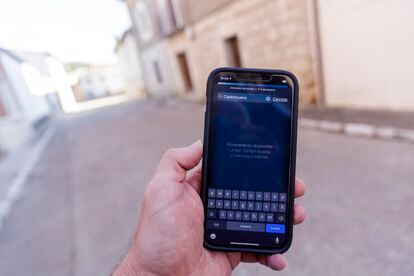How to bridge the digital divide between urban and rural Spain?
Many residents of sparsely populated areas have little to no cellphone reception, something that also stops city dwellers from moving to the countryside
/cloudfront-eu-central-1.images.arcpublishing.com/prisa/65PF2C7SBRB3VDEWHM72S2DX4Y.jpg)

Drivers on the 70-kilometer stretch of road between the city of Soria and the small town of San Esteban de Gormaz, in northern Spain, should not expect to get too many cellphone messages, as reception between the two points is very poor. The journey from the provincial capital involves a national road and a highway, but even when passing through towns, the signal is sporadic. Something as simple as sending an email or a WhatsApp message from these locations is close to impossible; not only is there no mobile network service, but the lack of potential customers means there is no incentive for companies to provide one.
The result is that in 2021 there are still expanses of Spain where people can barely use a cellphone, send a text message or surf the internet. For people living in these areas, their experience is likely to be similar to that of the 300 residents of Castronuevo de Esgueva, located just 12 kilometers from the prominent city of Valladolid, where the phone rarely proves itself to be more than an expensive toy in the owner’s pocket. For Purificación García, 65, there are two specific points in and around her stone-walled house that will at times afford a signal, one of them being a tiny area next to the well in her garden.
If it rains, she resorts to Plan B, which is to go up to the old attic, which was once a grain store, and seek out coverage among the beams and cobwebs. The house no longer has a landline as it is not inhabited year-round. “With the cellphone, I am less well connected to the outside world than when there was a landline,” she says.
The few locations where communication is guaranteed in the village are in the main square, where the authorities have installed a public Wi-Fi network, and on the road to the cemetery. Those who need to send an email or make a phone call can be found there. In the event of an accident or any other emergency, the only way of asking for help in many parts of the town is to shout, as García points out.
The situation is even worse in mountainous or geographically isolated areas. For the 50 inhabitants of Soto de Sajambre, in the northern province of León, a “reception point” was set up on top of a rock several years ago. Whoever wanted to make a call on their phone had to climb the rock. Ramón Barreira, 57, who lives in the town of Terroso, close to the border between the Spanish province of Ourense and Portugal, finds himself in a similar predicament. “Very badly, this is going very badly,” he grumbles in a thick Galician accent, explaining that the locals have to walk two kilometers to return to the 21st century.

The problem affects many parts of rural Spain, where residents have worse access to all services in general compared to other European Union countries, according to a recent study by the Bank of Spain. This institution’s last annual report pointed out that Spain’s population is highly concentrated, leaving an abnormally high percentage of uninhabited territory.
Sorting this problem is the domain of Spain’s department of Telecommunications, where a source said their work involves offering subsidies to encourage the provision of these services in areas where the companies’ services fall short due to the lack of potential customers and, therefore, profit incentive.
The maps managed by the department divide affected areas in two: white areas where there is no broadband access, greatly limiting coverage; and grey areas where the operator provides 30 megabytes of connection, which might have been considered decent 10 years ago but does not meet the demands of internet use in 2021. The white areas are home to around 1.5 million people, according to the department, while the grey areas have no population estimate.
According to the authorities, Spain is ahead of the rest of Europe regarding rural fiber optic internet connections, with 60.5% of its rural territory covered, up from 5.6% in 2015. One of the key objectives is to bring broadband to 100% of the country by 2025 with the support of European Union funds, but there is still a long way to go.
The lack of digital resources in Spain’s countryside is something that Pablo Delgado is familiar with. A 27-year-old economist and lawyer, his family comes from Valbonilla, a village of 50 inhabitants in the province of Burgos. Currently working between Madrid and Valladolid, Delgado previously worked in the European Parliament in Brussels and in the European Central Bank in Frankfurt, and he can hardly believe that, when he returns to Valbonilla, there is no way for farmers to phone or message each other should they need to borrow a tool or trailer or even ask for help with the sheep; they have to actually turn up in person. It’s even scarier when a farmer doesn’t answer his phone for hours. “You don’t know if they can’t get through because there’s no signal or if they’ve had an accident with the tractor,” he says.
Digital deserts are also the lot of those lobbying in political environments for the balance between rural and urban Spain to be redressed. Beatriz Martín, a senator representing the small regional party Teruel Existe, which demands fair and equal treatment for the province of Teruel, is all too familiar with the scenario. She comes from Bueña, a village of 60 residents, where all it takes is a gust of wind or a storm for the area’s fragile network to collapse. The phone she was given as a senatorial perk in Madrid is of no use here, because her contract is with a company that doesn’t provide a signal in Bueña. More than once she has had to work from her car, parked in areas with decent reception.
Martín says that several friends of hers currently living in large cities would like to settle in Bueña, but the lack of telecommunications puts them off. Teruel Existe has done “field work” to analyze which parts of Teruel province lack coverage: several members have traveled by car on the province’s roads with their phones’ GPS turned on, in order to pinpoint the spots where it is impossible to make contact with the outside world, not even to call for an ambulance. The study flagged up “between 20 and 30 kilometers” of absolute isolation. While city dwellers might appreciate the peace that comes with the lack of a mobile signal when venturing into the countryside, Martín makes a desperate plea: “We are not asking for great services, but for something of quality, a normal speed,” she says.
English version by Heather Galloway.
/cloudfront-eu-central-1.images.arcpublishing.com/prisa/SDQHML5F7ZHQHE46Y2TWTM4NUI.JPG)
/cloudfront-eu-central-1.images.arcpublishing.com/prisa/X7NHCFADQYVVQLSR66OOKU2P7M.jpg)










































